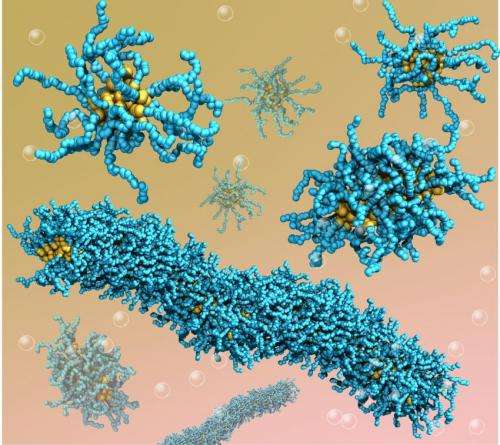Researchers develop models to study polyelectrolytes, including DNA and RNA

Researchers from North Carolina State University have developed a novel and versatile modeling strategy to simulate polyelectrolyte systems. The model has applications for creating new materials as well as for studying polyelectrolytes, including DNA and RNA.
"Our new technique allows us to model much larger and more complex polyelectrolyte systems, and to do so much more quickly," says Nan Li, lead author of a paper on the work and a Ph.D. student in NC State's Department of Materials Science and Engineering. "This is a big step forward for this field."
Polyelectrolytes are chains of molecules that are positively or negatively charged when placed in water. Because they are sensitive to changes in their environment, polyelectrolytes hold promise for use in applications such as drug delivery mechanisms. The term polyelectrolyte system refers to any collection of molecules that interacts in some way and includes polyelectrolytes.
Researchers are interested in computation models that simulate the behavior of polyelectrolyte systems because these models can be used to determine which polyelectrolytes are most likely to have desirable characteristics for use in various applications. The models can also be used to help researchers understand the behavior of polyelectrolyte systems such as DNA, RNA or synthetic ionic polymers.
Polyelectrolyte systems are difficult to model, because the systems can be large and include a lot of ions that can interact with the polyelectrolytes, changing the actual charge, shape, properties and behaviors of the polyelectrolytes. The change in charge affects how the polyelectrolytes interact with each other. The more ions there are in the system, the more likely it is that the polyelectrolytes will be drawn to each other. This interaction of polyelectrolytes changes the behavior and characteristics of the overall system.
"The problem is that tracking all of the ion-polyelectrolyte interactions takes a lot of computing power," Li says. "We've developed a more efficient technique to account for the effect of the ions, and that allows us to use less computing power and get quicker results. The computational cost of calculating the electrostatic interactions between the ions and polyelectrolytes is reduced to zero because the parameter is already accounted for within an existing model."
"Previous modeling techniques took an explicit approach, accounting for each individual ion," says William Fuss, an undergraduate at NC State and co-author of the paper. "Our technique takes an implicit approach, which is why we call it the 'implicit solvent ionic strength method,' or ISIS. We use a single parameter to control for the effect of the ions in a Dissipative Particle Dynamics model, which is already in widespread use. That means our method could be easily implemented by anyone using DPD software."
Using the ISIS method, researchers can identify potential polyelectrolyte system candidates for an application and then control the behavior of the polyelectrolytes by tweaking the number of ions in the system. This is done by increasing the concentration of salts in the system, because all salts are ionic when in an aqueous solution.
More information: The paper, "An implicit solvent ionic strength (ISIS) method to model polyelectrolyte systems with dissipative particle dynamics," is published online in the journal Macromolecular Theory and Simulations.
Provided by North Carolina State University



















